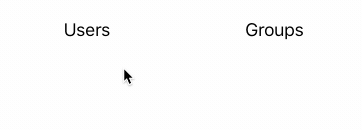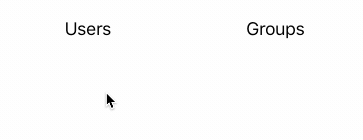Tabs
By using <select-single> with selection styles and behaviors, we can create a tabbed interface that allows a user to switch between two pieces of content on one screen.

Let's start with the markup for the tabs. Since only one tab can be selected at a time, we can use <select-single> to capture this state:
<doc xmlns="https://hyperview.org/hyperview">
<screen>
<body style="Main">
<select-single name="tab" style="Tabs">
<option value="users" style="Tab">
<text style="Tab__Label">Users</text>
</option>
<option value="groups" style="Tab">
<text style="Tab__Label">Groups</text>
</option>
</select-single>
<view id="tabContent" />
</body>
</screen>
</doc>
The result:

Using <style> rules with a <modifier> element for the selected state, we can visualize which tab is currently selected:
<styles>
<style id="Main" flex="1" paddingTop="48" backgroundColor="white" />
<style
id="TabContent"
flex="1"
justifyContent="flex-start"
alignItems="center"
paddingTop="24"
/>
<style id="Tabs" flexDirection="row" height="40" />
<style
id="Tab"
backgroundColor="white"
flex="1"
flexDirection="row"
justifyContent="center"
alignItems="center"
>
<modifier selected="true">
<style backgroundColor="#ddd" />
</modifier>
</style>
<style id="Tab__Label" fontSize="18" fontWeight="normal">
<modifier selected="true">
<style fontWeight="bold" />
</modifier>
</style>
</styles>
Note that modifier states apply to the children of an <option> element. This means we can change the look of the tab label when the tab is selected.
We now have some basic tabs that toggle when pressed:

All that remains is to add behaviors to the <option> elements that will replace the container content:
<doc xmlns="https://hyperview.org/hyperview">
<screen>
<styles>...</styles>
<body>
<select-single name="tab" style="Tabs">
<option
value="users"
style="Tab"
trigger="select"
href="/users"
action="replace-inner"
target="tabContent"
>
<text style="Tab__Label">Users</text>
</option>
<option
value="groups"
style="Tab"
trigger="select"
href="/groups"
action="replace-inner"
target="tabContent"
>
<text style="Tab__Label">Groups</text>
</option>
</select-single>
<view id="tabContent" style="TabContent" />
</body>
</screen>
</doc>
When a tab triggers a "select" (aka when the user selects the tab by pressing it), we request the tab's content and replace the elements in tabContent with the response:

Due to the delay of a remote request, notice that the appearance of a tab's content lags behind when the tab is selected. To address this, we can add a tab loading state.
<doc xmlns="https://hyperview.org/hyperview">
<screen>
<styles>...</styles>
<body>
<select-single name="tab" style="Tabs">
<option
value="users"
style="Tab"
trigger="select"
href="/users"
action="replace-inner"
target="tabContent"
show-during-load="spinner"
hide-during-load="tabContent"
>
<text style="Tab__Label">Users</text>
</option>
<option
value="groups"
style="Tab"
trigger="select"
href="/groups"
action="replace-inner"
target="tabContent"
show-during-load="spinner"
hide-during-load="tabContent"
>
<text style="Tab__Label">Groups</text>
</option>
</select-single>
<view id="tabContent" style="TabContent" />
<view id="spinner" hide="true" style="TabContent">
<spinner />
</view>
</body>
</screen>
</doc>
Below the <view> for the tab content, we add another view that includes a spinner. This view is hidden by default. When the user selects a tab, we use hide-during-load and show-during-load attributes to show the spinner and hide the existing tab content:

In the example above, there's no default state selected when the screen first loads. In a real-world scenario, one of the tabs would be pre-selected and the tab content would be pre-populated in the initial server response.
